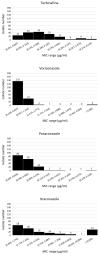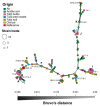Epidemiological Studies of Pan-Azole Resistant Aspergillus fumigatus Populations Sampled during Tulip Cultivation Show Clonal Expansion with Acquisition of Multi-Fungicide Resistance as Potential Driver
- PMID: 34835504
- PMCID: PMC8618125
- DOI: 10.3390/microorganisms9112379
Epidemiological Studies of Pan-Azole Resistant Aspergillus fumigatus Populations Sampled during Tulip Cultivation Show Clonal Expansion with Acquisition of Multi-Fungicide Resistance as Potential Driver
Abstract
Pan-azole resistant isolates are found in clinical and environmental Aspergillus fumigatus (Af) populations. Azole resistance can evolve in both settings, with Af directly targeted by antifungals in patients and, in the environment, Af unintendedly exposed to fungicides used for material preservation and plant disease control. Resistance to non-azole fungicides, including methyl benzimidazole carbamates (MBCs), quinone outside inhibitors (QoIs) and succinate dehydrogenase inhibitors (SDHIs), has recently been reported. These fungicide groups are not used in medicine but can play an important role in the further spread of pan-azole resistant genotypes. We investigated the multi-fungicide resistance status and the genetic diversity of Af populations sampled from tulip field soils, tulip peel waste and flower compost heaps using fungicide sensitivity testing and a range of genotyping tools, including STRAf typing and sequencing of fungicide resistant alleles. Two major clones were present in the tulip bulb population. Comparisons with clinical isolates and literature data revealed that several common clonal lineages of TR34/L98H and TR46/Y121F/T289A strains that have expanded successfully in the environment have also acquired resistance to MBC, QoI and/or SDHI fungicides. Strains carrying multiple fungicide resistant alleles have a competitive advantage in environments where residues of multiple fungicides belonging to different modes of action are present.
Keywords: Aspergillus fumigatus; CYP51A; aspergillosis; azole fungicides; clonal lineages; fungicide resistance; fungicide target proteins.
Conflict of interest statement
The authors declare no conflict of interest and the funders had no role in the design of the study; in the collection, analyses, or interpretation of data; in the writing of the manuscript, or in the decision to publish the results.
Figures




Similar articles
-
The Multi-Fungicide Resistance Status of Aspergillus fumigatus Populations in Arable Soils and the Wider European Environment.Front Microbiol. 2020 Dec 15;11:599233. doi: 10.3389/fmicb.2020.599233. eCollection 2020. Front Microbiol. 2020. PMID: 33384673 Free PMC article.
-
Multiresistance to Nonazole Fungicides in Aspergillus fumigatus TR34/L98H Azole-Resistant Isolates.Antimicrob Agents Chemother. 2021 Aug 17;65(9):e0064221. doi: 10.1128/AAC.00642-21. Epub 2021 Aug 17. Antimicrob Agents Chemother. 2021. PMID: 34152819 Free PMC article.
-
Azole-resistant Aspergillus fumigatus in the environment: Identifying key reservoirs and hotspots of antifungal resistance.PLoS Pathog. 2021 Jul 29;17(7):e1009711. doi: 10.1371/journal.ppat.1009711. eCollection 2021 Jul. PLoS Pathog. 2021. PMID: 34324607 Free PMC article. Review.
-
First detection of TR46/Y121F/T289A and TR34/L98H alterations in Aspergillus fumigatus isolates from azole-naive patients in Denmark despite negative findings in the environment.Antimicrob Agents Chemother. 2014 Sep;58(9):5096-101. doi: 10.1128/AAC.02855-14. Epub 2014 Jun 16. Antimicrob Agents Chemother. 2014. PMID: 24936595 Free PMC article.
-
Resistance in human pathogenic yeasts and filamentous fungi: prevalence, underlying molecular mechanisms and link to the use of antifungals in humans and the environment.Dan Med J. 2016 Oct;63(10):B5288. Dan Med J. 2016. PMID: 27697142 Review.
Cited by
-
Moving beyond multi-triazole to multi-fungicide resistance: Broader selection of drug resistance in the human fungal pathogen Aspergillus fumigatus.PLoS Pathog. 2025 Feb 10;21(2):e1012851. doi: 10.1371/journal.ppat.1012851. eCollection 2025 Feb. PLoS Pathog. 2025. PMID: 39928648 Free PMC article. No abstract available.
-
MinION Sequencing of Fungi in Sub-Saharan African Air and a Novel LAMP Assay for Rapid Detection of the Tropical Phytopathogenic Genus Lasiodiplodia.Pathogens. 2024 Apr 17;13(4):330. doi: 10.3390/pathogens13040330. Pathogens. 2024. PMID: 38668285 Free PMC article.
-
Comprehensive Review of Environmental Surveillance for Azole-Resistant Aspergillus fumigatus: A Practical Roadmap for Hospital Clinicians and Infection Control Teams.J Fungi (Basel). 2025 Jan 25;11(2):96. doi: 10.3390/jof11020096. J Fungi (Basel). 2025. PMID: 39997390 Free PMC article. Review.
-
Ornamental plants as vectors of pesticide exposure and potential threat to biodiversity and human health.Environ Sci Pollut Res Int. 2024 Aug;31(36):49079-49099. doi: 10.1007/s11356-024-34363-x. Epub 2024 Jul 24. Environ Sci Pollut Res Int. 2024. PMID: 39044056 Free PMC article.
-
Aspergillus fumigatus in the Food Production Chain and Azole Resistance: A Growing Concern for Consumers.J Fungi (Basel). 2025 Mar 26;11(4):252. doi: 10.3390/jof11040252. J Fungi (Basel). 2025. PMID: 40278073 Free PMC article. Review.
References
-
- Snelders E., van der Lee H.A.L., Kuijpers J., Rijs A.J.M.M., Varga J., Samson R.A., Mellado E., Donders A.R.T., Melchers W.J.G., Verweij P.E. Emergence of azole resistance in Aspergillus fumigatus and spread of a single resistance mechanism. PLoS Med. 2008;5:e219. doi: 10.1371/journal.pmed.0050219. - DOI - PMC - PubMed
-
- Howard S.J., Cerar D., Anderson M.J., Albarrag A., Fisher M.C., Pasqualotto A.C., Laverdiere M., Arendrup M.C., Perlin D.S., Denning D.W. Frequency and evolution of azole resistance in Aspergillus fumigatus associated with treatment failure. Emerg. Infect. Dis. 2009;15:1068–1076. doi: 10.3201/eid1507.090043. - DOI - PMC - PubMed
-
- Lestrade P.P.A., Bentvelsen R., Schauwvlieghe A.F.A.D., Schalekamp S., van der Velden W.J.F.M., Kuiper E.J., van Paassen J., van der Hoven B., van der Lee H.A., Melchers W.J.G., et al. Voriconazole resistance and mortality in invasive aspergillosis: A multicentre retrospective cohort study. Clin. Infect. Dis. 2019;68:1463–1471. doi: 10.1093/cid/ciy859. - DOI - PubMed
-
- Fraczek M.G., Bromley M., Buied A., Moore C.B., Rajendran R., Rautemaa R., Ramage G., Denning D.W., Bowyer P. The crd1B efflux transporter is associated with non-cyp51a-mediated itraconazole resistance in Aspergillus fumigatus. J. Antimicrob. Chemother. 2013;68:1486–1496. doi: 10.1093/jac/dkt075. - DOI - PubMed
Grants and funding
LinkOut - more resources
Full Text Sources

